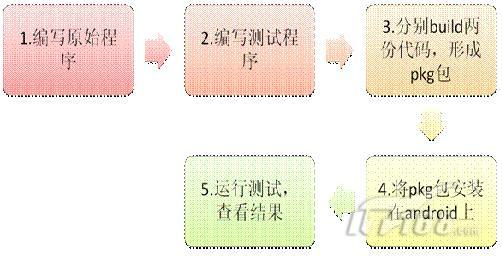如何在Android中利用Instrumentation来进行测试?
在介绍具体的命令之前,我们先理解一下单元测试的层次。一组单元测试可以被组织成若干个TestSuite。每个TestSuite包含若干 TestCase(某个继承android.jar的junit.framework.TestCase的类)。每个TestCase又包含若干个 Test(具体的test方法)。
如果假设com.android.foo是你的测试代码的包的根。当执行以下命令时,会执行所有的TestCase的所有Test。测试的对象就是在Target Package中指定的包中的代码:
adb shell am instrument -w com.android.foo/android.test.InstrumentationTestRunner
如果你想运行一个TestSuite,首先继承android.jar的junit.framework.TestSuite类,实现一个 TestSuite(比如叫com.android.foo.MyTestSuite),然后执行以下命令执行此TestSuite
adb shell am instrument -e class com.android.foo.MyTestSuite -w com.android.foo/android.test.InstrumentationTestRunner
其中的-e表示额外的参数,语法为-e [arg1] [value1] [arg2] [value2] …这里用到了class参数。
如果仅仅想运行一个TestCase(比如叫com.android.foo.MyTestCase),则用以下命令:
adb shell am instrument -e class com.android.foo.MyTestCase -w com.android.foo/android.test.InstrumentationTestRunner
如果仅仅想运行一个Test(比如就是上面MyTestCase的testFoo方法),很类似的,就这样写:
adb shell am instrument -e class com.android.foo.MyTestCase#testFoo -w com.android.foo/android.test.InstrumentationTestRunner
然后,所有的测试结果会输出到控制台,并会做一系列统计,如标记为E的是Error,标记为F的是Failure,Success的测试则会标记为一个点。这和JUnit的语义一致。如果希望断点调试你的测试,只需要直接在代码上加上断点,然后将运行命令参数的-e后边附加上debug true后运行即可。更加详细的内容可以看InstrumentationTestRunner的Javadoc。我希望Android能尽快有正式的文档来介绍这个内容。
如何在Android的单元测试中做标记?
在 android.test.annotation包里定义了几个annotation,包括 @LargeTest,@MediumTest,@SmallTest,@Smoke,和@Suppress。你可以根据自己的需要用这些 annotation来对自己的测试分类。在执行单元测试命令时,可以在-e参数后设置“size large”/ “size medium”/ “size small”来执行具有相应标记的测试。特别的@Supperss可以取消被标记的Test的执行。
完整的操作过程
总结以上所有的内容,编写并运行完整的测试需要以下的步骤:

以上步骤中,在 Android自带的例子中,我发现它有两个manifest.xml。也就是说在步骤3中源代码和测试代码分别生成了两个不同的包。然后步骤4利用 adb install命令安装到了虚拟机上。由于我没有找到Eclipse ADT有办法可以为一个只有Instrumentation,没有Activity的Application打包并安装,于是采用了略微不同的办法完成了这个工作。下文中将一一详细介绍整个过程。


